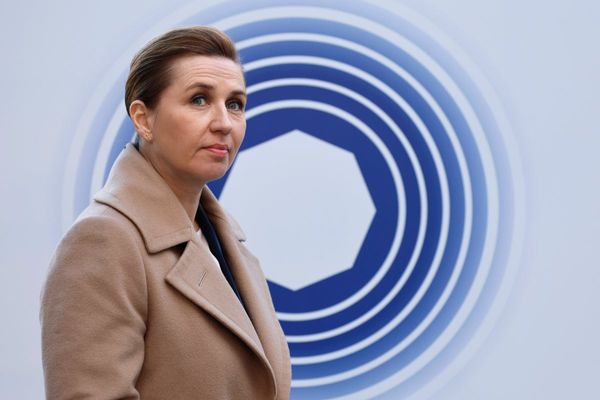
In the week after he was named secretary-general of China’s ruling Communist Party for a third time, Xi Jinping took his six fellow newly appointed members of the Politburo Standing Committee to the party’s “holy” land in Yan’an, in northern Shaanxi province.
Symbolism is tremendously important to Chinese leaders. Yan’an is where Mao Zedong held the party’s seventh Congress on the Long March and went on to win the country’s post-World War II civil war and seize power in 1949. It’s also where Mao met Xi’s father Xi Zhongxun, a key revolutionary general, in 1947. Xi himself had also worked nearby during the Cultural Revolution when he was “sent down to the countryside” to understand regular Chinese people.
After his 2012 and 2017 appointments to the top job, Xi visited Shenzhen — the sprawling metropolis close to Hong Kong — and Shanghai. The latter was the site of the CCP’s first meeting in 1912.
Under Xi, the practice of having CCP cells inside all businesses has become standard, including in major offshore companies operating inside China. The intention is to ensure businesses are aligned with party and government goals.
Like everything under Xi, it’s all about control and internal security and external security.
All this helps to explain that China is accepting lower growth in a trade-off for greater security, the key message Xi delivered at the party Congress when he secured his third term. And that’s just as well, because the country’s economy is riddled with problems, despite the latest GDP figures of 3.9% growth being better than expected. Xi is trying to engineer a climb down from go-go capitalism to a more equal spread of wealth, starting with the popping of the country’s property Ponzi.
None of this is good news for Australian Treasurer Jim Chalmers as he tries to at least begin to drag the nation’s budget from the mire. The fallout from China unwinding its reliance on property is being seen in the falling price of iron ore, the main component in steelmaking and by far Australia’s largest export to China.
Iron ore is below US$80 a tonne, its lowest since the pandemic took hold in 2020, and the outlook for China’s steelmaking is grim with Xi’s zero-COVID policy looking like staying well into, and probably past 2023. The latest major lockdown in the city of Wuhan — from where COVID emerged at the end of 2019 — has seen 800,000 people put under severe pandemic restrictions.
Treasury has dramatically lowered its forecast for iron ore and thermal coal, although markets think they are too low, so politically Chalmers is hoping for a happy surprise.
This week’s revelation that Australia will host US B-52 bombers as part of our ally’s ever-growing presence in Darwin may halt any warming of relations between Australia and China, including putting the brakes on any loosening of Beijing’s trade restrictions. China has reacted with typically colourful rhetoric to the news.
“The relevant US behaviours have increased regional tensions, seriously undermined regional peace and stability, and may trigger an arms race in the region,” a Chinese Foreign Affairs ministry spokesman said, seeming to forget that it was China that began dramatically increasing its military spending in recent decades.
“China urges parties concerned to abandon the outdated Cold War zero-sum mentality and narrow geopolitical mindset, and do more things that are good for regional peace and stability and mutual trust among all parties.”
Under China’s trajectory, these tensions will only continue, pushing Australia to continue looking elsewhere for markets. Despite all the talk of so-called decoupling — unravelling the tight links between China and the US in particular — any talk of what’s happening in the world’s second largest economy cannot be discussed as a standalone issue. Like its bigger rival, China has strong trade relationships with most countries, especially in the region. Apart from the Philippines, whose largest trading partner is the US, every other country in South-East and North Asia has China as its largest trading partner.
China’s slowdown will be felt hardest by commodity-exporting countries such as Australia and Indonesia, but the whole region will suffer to a certain degree. There are opportunities, though, especially as the zero-COVID policy means business people who want to visit China will continue to have to quarantine and risk being locked down. Indeed, the drift of Western business people out of China and Hong Kong is continuing.
Yet other countries in the region will benefit from Xi’s policies as investors seek lower wage jurisdictions, more friendly access to their markets, and less draconian health policies.
Swathes of manufacturing have already shifted from China into Vietnam, Malaysia, Indonesia and further afield to South Asian countries such as India, Bangladesh and Pakistan. Vietnam in particular has moved up the value chain in a way that Thailand and Malaysia had in previous decades, capturing a chunk of the important mobile phone business, a trend that’s likely to continue.
The slowdown in Europe and the US will certainly mean lower growth in regional exports, but a unique opportunity for Australia has emerged in a region that has been ignored, particularly by Canberra, for too long.
The Albanese government and its Foreign Affairs Minister Penny Wong have affirmed that it is a fresh priority, but diplomatic attention needs to go hand in hand with growing economic ties that now, more than ever, make financial sense.







